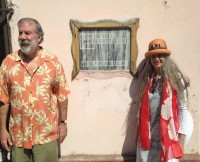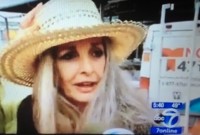White Plains Councilwoman One of First to Visit Cuba

White Plains Councilwoman Milagros Lecuona and her partner Dan Stoddard, VP and CIO at the American Museum of Natural History in New York City, were among the first Americans to travel to Cuba since relations between Cuba and the United States relaxed earlier this year.
The couple spent a busy week with an itinerary designed just for them to view many of the historical and cultural sites around the country.
“We had been wanting to travel to Cuba for a while,” Lecuona said in a phone interview Monday. “This is an important time right now and we wanted to be able to see the before and after.”
On the way they stopped in Miami to take in the atmosphere of the Cuban section of the city before heading off to Havana. On the way home they were surprised to find they were on the first historic flight from Cuba to New York City.
“We thought because there were so many people in the airport that everyone was going to New York, but they got on a flight to Miami and only about 10 passengers boarded for Kennedy International Airport,” Lecuona said.
With Stoddard’s background in museums, the couple spent most of their time in art galleries and museums. “There was no time for the beach or relaxing,” Lecuona explained. “Cultural tourism is the big thing right now, and has been for the past year and a half or so.”
She was most impressed with the Cuban National Museum, which houses political art, colonial art, landscapes; all types of local art.
She also was surprised that so many Cubans were able to communicate in English – although Lecuona, a native of the Canary Islands, Spain, had no trouble at all with the dialect – the couple was welcomed with much enthusiasm.
“Everything we asked about the history or art was answered, even if our guides did not have the information at hand, we would receive a package in our hotel room the next morning. Their knowledge of the details was unbelievable,” Lecuona said.
The people are well-educated, she continued, and the cultural tourism and health industries had improved greatly, especially over the past five years. She saw many examples where the Chinese had made investments, although Lecuona was quick to point out that any business partnerships with outside parties had to include a Cuban partner.
In Havana the housing, sewers and public transportation are in need of investment she noted.

In the countryside outside Havana, where the couple traveled, Lecuona said it was amazing how the villages had remained so pristine, like they were ages ago.
Especially important to Lecuona was the familiarity she felt with the people in the countryside. Many were descendants of people from the Canary Islands who had traveled to Cuba in the 1500s. The relationship between the two islands has remained to this day.
“About 85 percent of the people have some relationship with the Canary Islands,” Lecuona explained, and the influence can be seen in the art and architecture. Also, there are some shared words that clearly came from the indigenous population.
Famous in the country is Ernesto Lecuona, a well-known composer, and the Councilwoman’s great uncle. His father, who was born in Tenerife, the Canary Islands, moved to Guanabacoa, Cuba, where Ernesto was born.
Ernesto, after the family moved to Miami, also moved later to New York and then spent his last years before he died in Tenerife. He is now buried in Gate of Heaven Cemetery in Hawthorne.
Lecuona said her biggest takeaway from the adventure was the beauty of the country with a beautiful future. She took as many as 400 to 500 photos to make comparisons at some point.
“The Cuban people are looking to the future. They would have liked to have had this opportunity 20 years ago, but they are happy for it now.”
